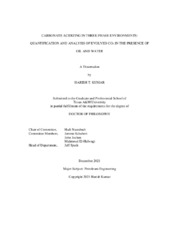| dc.description.abstract | Success rates of carbonate acidizing when upscaling from single, aqueous-phase laboratory analyses to field-scale levels have been poor. Analyzing matrix acidizing performances in carbonate reservoirs with two-phase environments. i.e., oil and water, has picked up importance currently in the stimulation industry. A lack of understanding of the mechanisms taking place in this complex subsurface process still exists, particularly with carbon dioxide (CO₂) evolution from limestone dissolution and the presence of a secondary/tertiary fluid phase in the medium.
A detailed investigation via experimental corefloods and numerical modeling studies is performed for fully aqueous and aqueous/hydrocarbon environments in the porous media. A 15 wt% hydrochloric (HCl) acid is used in treating outcrop Indiana limestone cores of moderate permeability, at initial pore pressures of 600 and 1,200 psi, and temperatures of 70 and 150°F. Analysis of the evolved CO₂ and its ensuing effects from acidizing carbonate rocks is conducted in different rock wettability conditions.
A compositional simulation technique is adopted to understand the process thoroughly. Validation of the numerical model is conducted by replicating acidizing experiments in fully aqueous environments, described in published literature, and performed in the laboratory. The calibrated numerical model for fully aqueous environments is later extended to study aqueous/hydrocarbon environments. Lessons learned from the lab-scale are applied to a field-scale scenario via a numerical model with radial coordinates.
Cores with residual oil at water-wet conditions yielded the least acid pore volumes to breakthrough (PVbt). Contrary to popular belief, high pore pressures of 1,000 psi and above are not sufficient to keep all the evolved CO₂ in solution. The presence of CO₂ as a separate phase hinders acid efficiency.
The reach or extent of the evolved CO₂ is shown to exist only near the damage zone and seldom penetrates the reservoir matrix. Based on the field scale model's predictions, this study warrants conducting acidizing experiments at the laboratory level, at exactly similar pressure, temperature, and salinity conditions faced in the near-wellbore region, and urges the application of compositional modeling techniques to account for CO₂ evolution, while studying and predicting matrix acidizing jobs. | |


